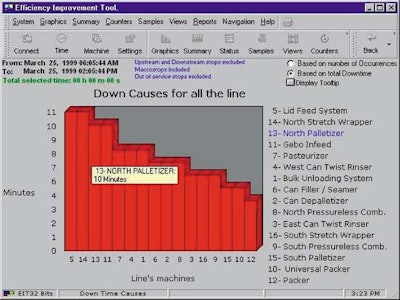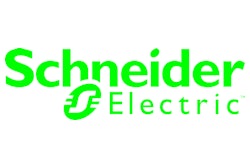
When a brewer as prolific as Miller can increase its plant output by more than 4%, shorten its line start-up time by 20% and reduce its downtime, it’s living the high life.
Those figures exemplify some of the benefits Milwaukee-based Miller Brewing Company is enjoying since it began using Gebo Industries Canada’s (Laval, Quebec, Canada) Efficiency Improvement Tool (EIT) software. The software diagnostic tool monitors packaging lines at six Miller plants nationwide. The company uses that information to improve efficiencies of lines at all six of those U.S. plants, for lines that fill glass, can and plastic bottles.
While Miller won’t divulge specific financial savings from EIT, they’re likely to be substantial given the brewer’s volume. So substantial that Miller can justify a nearly six-figure dollar investment for total implementation costs for each of the 57 lines on which EIT will be installed in the next two years. Those investment figures come from Larry Trunek, Miller’s senior electrical corporate engineer.
“Miller has been trying to monitor line activities for more than 25 years,” Trunek reports. “And in the 18 years I’ve been with Miller, I know of at least seven different variants we’ve tried—unsuccessfully. We’ve tried to capture efficiencies and personnel performance on a line. We found that met with resistance.
“We used Gebo for some packaging line consulting and they showed us an application they developed in concert with another brewer,” he recalls. “We were impressed and said we’d like to experiment with it in our facility. That was about three years ago.”
The first installation of the software was on a glass bottling line in the Milwaukee plant in early ’97. Since then, EIT has been added to lines in Irwindale, CA, Fort Worth, TX, Albany, GA, Trenton, OH, and Eden, NC. Trunek says the software may also be used at a recently acquired facility in the Northwest. “The software is used with glass lines, aluminum can lines, kegs and for plastic bottles on a retrofitted glass line in Fort Worth.” As of April, EIT was in place on 37 of the 57 lines.
Volume demands efficiency
A “typical” bottling line at Miller includes a depalletizer, uncaser, rinser, filler, pasteurizer, labelers, case packers, slitter/sealers, palletizer and stretch wrapper. Between equipment and labor costs, a new line represents an investment of $15 million to $25 million, Trunek says. Lines run around the clock, at speeds of around 2ꯠ cans/min, 1괌 glass bottles/min, 850 plastic bottles/min or kegs at 620 half barrels/hr. Each barrel contains 31 gal of the suds. Trunek says Miller measures line efficiency by the amount of barrels/hr it produces. “Our packaging lines range from 130 to 280 barrels per hour,” he estimates.
He adds, “a one-percent increase [in line output] equates to big dollars for us.” Volume appears to be a key justification for the system. Trunek adds, “We developed our version of the software with Gebo to give us more functionality.”
Miller’s involvement in the developmental process helped the brewer earn a price advantage for its EIT investment. That investment includes a one-time licensing fee per packaging line, and “installation costs.” Those costs, Trunek says, “include modifying PLC codes on the equipment, installing the software, setting up our database and entering parameters for data collection.” Average total cost per line, he says, comes to about $90ꯠ. And while he admits it’s quite an investment, he says it’s one that’s paying off handsomely.
“Because of our volume, and the profit margin on dollars per case, it definitely pays for us,” he states. “It’s a real increase in our bottom line. If you use the tool properly, payback is tremendous.” For Miller, “payback is in the neighborhood of two to three years per line,” Trunek says.
Networking works
How does EIT provide such a payback? To answer the question, it’s important to know what the software includes and how Miller uses it. Miller developed a series of “fault” codes for each machine. For example, on a filler there are 99 fault codes. A code is assigned to a specific problem that could shut the line down, such as a missing crown or cap, a dented case, missing machine component, etc. The same codes are used for each filler at each plant to create standardization throughout the company. The Gebo system allows Miller to add, delete or modify codes as needed.
Trunek explains that Gebo’s “EIT Writer portion of the software looks at the PLC for each machine on the line and collects the information.” EIT Writer is contained on a PC in a computer room. Machine data is taken from the PLC by Modicon-brand hardware from Schneider Automation (North Andover, MA) and is transferred across an Ethernet wide-area-network to a database that’s stored on a server at each plant. Any brand of PLC can be used. Trunek says the EIT Client portion of the Gebo software tool is available to virtually everyone at any Miller plant who can access data from the database from their PC.
Each line can have 20 to 40 PLCs, depending on the equipment on the line. “We also have a main PLC that controls all the conveyors between machines. The EIT Writer ‘talks’ to each of those PLCs via the Modbus Plus network.
“This is the first piece of software that we’ve seen that makes a truly unique difference in that it tracks the efficiency of equipment, identifying internal and external problems relating to the machine,” Trunek explains.
Troubleshooting
Trunek says that Miller lines operate on what he refers to as a “balanced line flow.” He elaborates: “That is a concept where you identify a critical piece of equipment, in our case a filler. We want to do everything humanly possible to keep that filler running. By doing that, you have to have machinery upstream and downstream of the filler running efficiently. Those machines occasionally have breakdowns, and you don’t want them to have an impact on the filler.”
To keep its lines operating as efficiently as possible, Trunek says, “we have maintenance strategy task forces that look at productivity and what can be done. One of our main focuses is to reduce what we call ‘microstops’, which is any line stoppage with a duration of four minutes or less. Those would be jams of containers, cases not opening correctly in a packer or jams on conveyors. Believe it or not, microstops represent the majority of downtime on a packaging line.”
In the past, plant personnel had to make educated estimates of problematic areas. The EIT software tool eliminates the potential errors such estimates can create. “We had an example of that at one of our plants where everybody said the problem was at the case packer,” Trunek recalls. “But the software indicated the problem was at the labelers, not the packers. So we put some effort into the labeler areas and improved the efficiency of the line. The reports that EIT generate identify how much downtime occurs at a machine, and identify accumulation between machines. So if you use the data, and understand balanced line flow, you can identify bottlenecks.”
Trunek admits, “at first we were hesitant and skeptical as to all the benefits that could be had from the tool, so we decided to put EIT on a line where we hadn’t done any major modifications in the last three to five years. We did that test on one of our lines near the end of 1998. After we installed it, people at the plant began using the tool to identify problems. The line efficiency, or output, increased by 4.1 percent the following year compared to the same time period before when EIT wasn’t used. That’s a considerable increase.”
Trunek explains, “the software is very intuitive. It takes a minimal amount of training to use. Gebo did the installation and provided us with a utility so that we could add, delete or modify PLC codes or fault detection, so we don’t have to drag them back in here [for tweaking the system],” he says.
“We’re able to use that information by going to our vendors to help them improve the efficiency of their equipment, even before they deliver it to us.”
Vendors adapt
“When we install a new packaging line, our vendors are now coming on board with us and saying, ‘yes, we’ve looked at your EIT tool and we will use it to meet our performance guarantee to you.’”
Now, Trunek says, “we can track 13 months’ worth of historical data and use it for justification for replacement or upgrading of equipment.
“To get this information to the equipment operators, we’re also putting an average of three PCs on the floor for each line so operators can readily access the information,” he explains. “It’s available to all the technicians, staff engineers, line managers and management. But we also want operators on the line to have a better feel for performance of each machine on the line.”
Factual line data not only benefits the bottom line at Miller, but it also prevents fingerpointing. “In the past,” Trunek realizes, “performance ratings were subjective. Now we look at the tool and can see that a machine is stopped because the operator pushed the stop button. We can tell how many times [it was stopped], for how long and we can use the tool to identify the problem and correct it.”






















